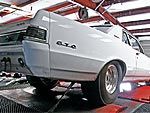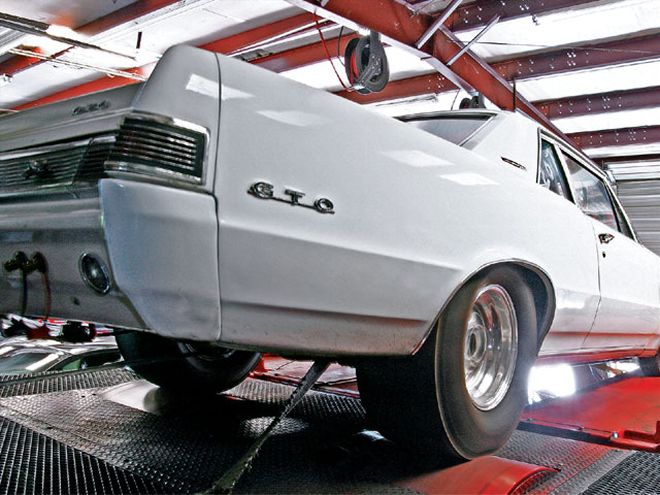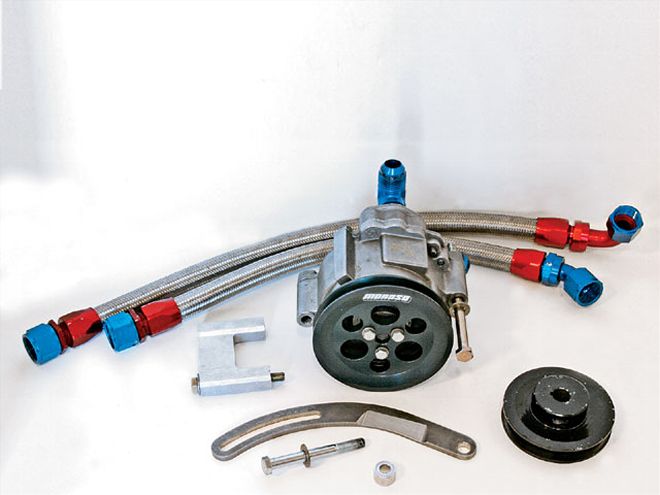

Hobbyists and pros build race engines to make the most power possible within the constraints of a budget and the design limits of the motor. For all the power that they produce, a keen eye must be kept on efficiency as well. Proper piston-ring seal is paramount to getting the most out of any engine.
Since the factory PCV system is not used on most race engines because it's less effective than on a stocker, positive pressure in the crankcase builds as engine rpm is increased. The result is pressure on the underside of the piston on the intake and power strokes, which reduces efficiency by offering more resistance to the piston's downward movement in the bore. It also places more stress on the piston rings, thereby reducing their seal capabilities and increasing the chance of blow-by. If that weren't enough, high crankcase pressure also forces oil to evacuate through any seal it can breach. On Pontiacs, the rear main seal, valve covers, and oil-dipstick tube are usually the first to seep.

The addition of a vacuum pump to remove the positive pressure in the crankcase and introduce a few inches of negative pressure (vacuum) can increase power production and improve the seal of the piston rings and all those places where oil used to leak.
There are three common vacuum-pump methodologies on the market today; header/collector aspiration vacuum, electric vacuum pumps, and belt-drive vacuum pumps.
Header/collector systems work well on open-headered cars but generally only pull about 1-2 inches of vacuum from a race engine. Mufflers, now mandatory at a great many tracks in the country, can render this system ineffective as even minor backpressure from the exhaust system will drop the pumping efficiencies to almost zero.
Electrical vacuum pumps are available and easy to install but can't pump enough volume to produce more than 2-3 inches of vacuum.
From an effectiveness standpoint, a belt-driven vacuum pump provides more vacuum to relieve the crankcase pressure, thus eliminating oil leaks and allowing the piston rings to seal better. Of course, there are downsides. The pump has to be mounted so that it can be driven off of the crankshaft pulley, bringing into consideration packaging constraints that presently will not allow the factory GM air-conditioning units to remain unless custom brackets are fabricated.
According to David Butler of Butler Performance, "For street vehicles that see routine highway miles or spirited weekend-driving duties, owners should definitely retain the factory PCV valve and standpipe with a breather element to reduce the chance of oil leaks if the use of a vacuum pump is not a viable option.
"For aggressive engine builds that feature long strokes, high cylinder pressures, or elevated rpm potential, an Evac Pump Kit is a great way to stop oil leaks and pick up a few extra horsepower. To eliminate oil leaks on a Pontiac, we like to see between 5 and 10 inches of vacuum with a maximum of 14 inches. Some oil mist inside the engine is critical to ensure proper lubrication of the parts that don't have direct oil flow such as the wristpins.
"By designing custom brackets to fit either a modified Ford-style vacuum pump or a Moroso pump, we've created an easy solution to the issues created by too much crankcase pressure. In addition to solving the unsightly oil leaks, by reducing crankshaft pressure the intake manifold charge isn't contaminated with oil, and the additional ring seal consistently produces measurable horsepower gains. On a typical 500-horse engine, the modified Ford-style pump used in our standard kit generally creates 8-12 hp on an engine dyno while the Moroso pump gains 15-25 hp."
Follow along as we install and test both the Butler Performance standard and Moroso-based Evac Pump Kits. Installation was completed by George Reaves, the owner of the '65 GTO test car at Real Performance Motorsports (RPM) in Lewisville, Texas. Once installation was complete, both systems were dyno tested at RPM and then raced at Redline Raceway in Caddo Mills, Texas.
Conclusion
It is apparent that both Butler Performance Evac Pump Kits are complete and well designed. Installation can be accomplished in 1-2 hours with the hardest tasks being where to locate the breather tank and cutting the braided hoses to length.
The choice of pumps comes down to the hobbyist's budget and goals. If the primary purpose of the pump is to stop any oil leaks, the standard kit will provide reliable service for years. For enthusiasts looking to gain a bit more horsepower and have the ability to rebuild their own pumps, the Moroso three-vane pump is a great choice.
Other than the ability to stop the pesky oil leaks that plague high-performance engines, the vacuum pumps can and should be used as aids in prolonging piston-ring and cylinder-seal integrity as well as valuable diagnostic equipment.
According to Butler, "By utilizing a dash-mounted vacuum gauge, the enthusiast can carefully monitor the condition of the engine's sealing abilities pass after pass. From a reliability and cost-effectiveness standpoint, both pumps have very good service lives. The GeeTO Tiger's standard evac pump lasted for five years before needing replacement. With replacement pumps retailing for $99 and the Moroso Rebuild Kit running $105, both systems are relatively inexpensive to maintain." For hot street cars and drag racers, a Butler Evac Pump Kit might just be the cure for your pressurized oiling blues.
Dyno Testing
Testing of the '65 GTO was performed at Real Performance Motorsports in Lewisville, Texas. RPM has a Dynojet Model-248C dyno. The car was running on drag slicks, which pulls down the rear-wheel horsepower on a chassis dyno compared to street tires. Due to electrical interference present in the ignition system, rpm was not recorded consistently across all pulls. In addition, torque is not noted as the torque maximums were always dependent on when the engine was floored and the converter was flashed.
Key Engine Parameters: air-inlet temperature (AIT). Vacuum was measured on a sealed system at a valve-cover bung at idle and at 6,000 rpm in Third gear. Maximum horsepower was achieved at 5,400 rpm.
The GTO's big-cube mill put out 340.7 hp in its baseline configuration. Although the firewall and valve covers were clean before the run, the pressure that built up in the engine pushed oil out of the dipstick tube, and it dripped onto the passenger-side header. In addition, the back of the driver-side valve cover was wet, and both breathers had oil residue where they mounted to the valve covers.
After cleaning the mess and finishing the installation of the standard Butler Evac Pump Kit, a vacuum gauge was connected to the passenger-side valve-cover fitting. At idle, the car registered 0 inches of vacuum being pulled from the engine-not unexpected since the pump was rotating so slowly. Once the GTO was unleashed, it was evident that the Evac Pump Kit was performing its job. At a maximum rpm of 6,000 in Third gear on the Turbo 400 transmission, the pump pulled 5 inches of vacuum, and the decreased pressure and more effective ring seal allowed horsepower to jump by almost 6. As significant was the fact that the pump completely eliminated the oil leaks that had previously plagued the car on the dyno.
Following a cool down, the Moroso Evac Pump Kit was installed, and the car was back on the dyno for testing. At idle, the three-vane Moroso pump pulled 1/2 inch of vacuum. Recorded at the same 6,000 rpm in Third gear, the pump generated 9 1/2 inches of vacuum and achieved an outstanding gain of 14.5 hp over the baseline.
As compared to the standard kit, the Moroso kit was able to pull out almost double the volume of pressurized crankcase gases, allowing even better ring seal and elevated horsepower numbers. Once again, the reduction of crankcase pressure kept any oil from escaping the engine.
CONFIGURATION AIT IDLE VAC MAX VAC HP GAINS Baseline 103.6 0 0 340.7 N/A Butler Std. Evac Kit 109.9 0 5 346.6 + 5.9 Butler Moroso 105.8 11/42 {{{911}}}/42 355.2 +8.6/+14.5 Three-Vane KitDrag Testing
Drag testing was conducted at Redline Raceway in Caddo Mills, Texas. Redline raceway is an eighth-mile venue, and on this day, it was hosting a bracket series held by the Texas Muscle Car Club Challenge. As George Reaves routinely laces up his spurs as a member of the Dallas Area Pontiac Association, the other member clubs in the Texas Muscle Car Challenge were happy to put aside their brand biases and allow testing at the conclusion of the bracket race.
George Reaves' (of Whitewright, Texas) '65 GTO is a former "Pontiac Pavement Pounders" participant, and the same combination of parts routinely puts the GTO into the 11.1-second e.t. bracket in the quarter with 7.2s in the eighth-mile. Powered by a '71 455 with round-port H.O. heads, the 12:1-compression engine uses an Ultradyne roller cam and Harland Sharp 1.65 roller rockers. Intake duties are handled by an Edelbrock Victor manifold and Holley 950 DP carburetor before dumping exhaust out of a set of Hooker headers.
An Art Carr 2,500-stall torque converter sends power through a Turbo-400 transmission and out back to a 3.90-geared Ford 9-inch rearend. ET drag slicks that measure 10.5x29x15 fill up the wheelwells.
The engine is shifted manually at 6,000 rpm and goes through the traps in the quarter-mile at 6,100 rpm. When run on an eighth-mile track, the car is barely able to shift into Third gear before the eighth-mile marker lights are tripped.
At the conclusion of drag testing, the difference in e.t. and mph between the best runs that were produced by the Moroso pump and the slowest runs without any vacuum pump were at or less than 0.04 in e.t. and 0.11 mph.
As expected, the short eighth-mile distance really didn't highlight the enhanced horsepower that the vacuum pump allows the engine to make, but more importantly, both units proved that they were the solution to stopping the oil leaks that would show up on the car at drag-racing venues. In addition to a clean engine compartment, there was no oil to be found on the bottom of the transmission pan, and the rear main seal was perfectly dry.
Configuration Temp 60-ft 1/8 ET/MPH No Pump 82.0 1.{{{57}}} 7.236/93.89 1.58 7.231/93.95 Butler Standard 82.0 1.58 7.213/93.99 1.57 7.216/93.92 Moroso 82.0 1.57 7.193/94.02 1.57 7.191/94.00Recommended Tools And Supplies